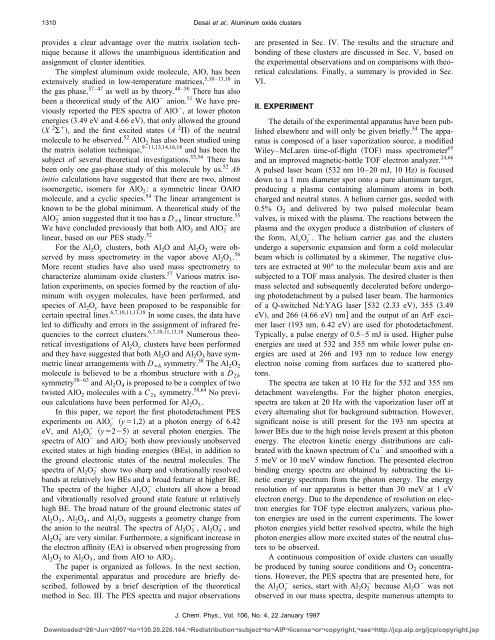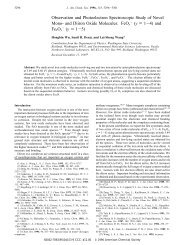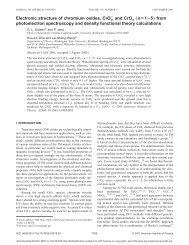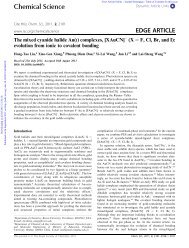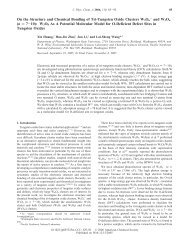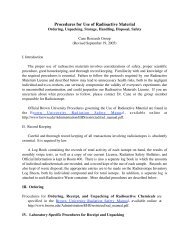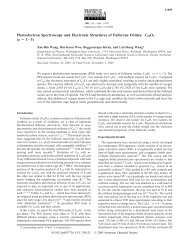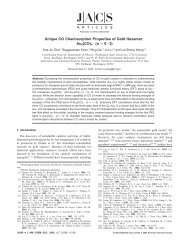A study of the structure and bonding of small aluminum oxide ...
A study of the structure and bonding of small aluminum oxide ...
A study of the structure and bonding of small aluminum oxide ...
You also want an ePaper? Increase the reach of your titles
YUMPU automatically turns print PDFs into web optimized ePapers that Google loves.
1310 Desai et al.: Aluminum <strong>oxide</strong> clusters<br />
provides a clear advantage over <strong>the</strong> matrix isolation technique<br />
because it allows <strong>the</strong> unambiguous identification <strong>and</strong><br />
assignment <strong>of</strong> cluster identities.<br />
The simplest <strong>aluminum</strong> <strong>oxide</strong> molecule, AlO, has been<br />
extensively studied in low-temperature matrices, 5,10–13,18 in<br />
<strong>the</strong> gas phase, 37–47 as well as by <strong>the</strong>ory. 48–50 There has also<br />
been a <strong>the</strong>oretical <strong>study</strong> <strong>of</strong> <strong>the</strong> AlO anion. 51 We have previously<br />
reported <strong>the</strong> PES spectra <strong>of</strong> AlO , at lower photon<br />
energies 3.49 eV <strong>and</strong> 4.66 eV, that only allowed <strong>the</strong> ground<br />
X 2 , <strong>and</strong> <strong>the</strong> first excited states A 2 <strong>of</strong> <strong>the</strong> neutral<br />
molecule to be observed. 52 AlO 2 has also been studied using<br />
<strong>the</strong> matrix isolation technique, 9–11,13,14,16,18 <strong>and</strong> has been <strong>the</strong><br />
subject <strong>of</strong> several <strong>the</strong>oretical investigations. 53,54 There has<br />
been only one gas-phase <strong>study</strong> <strong>of</strong> this molecule by us. 52 Ab<br />
initio calculations have suggested that <strong>the</strong>re are two, almost<br />
isoenergetic, isomers for AlO 2 : a symmetric linear OAlO<br />
molecule, <strong>and</strong> a cyclic species. 54 The linear arrangement is<br />
known to be <strong>the</strong> global minimum. A <strong>the</strong>oretical <strong>study</strong> <strong>of</strong> <strong>the</strong><br />
AlO 2 anion suggested that it too has a D h linear <strong>structure</strong>. 55<br />
We have concluded previously that both AlO 2 <strong>and</strong> AlO 2 are<br />
linear, based on our PES <strong>study</strong>. 52<br />
For <strong>the</strong> Al 2 O y clusters, both Al 2 O <strong>and</strong> Al 2 O 2 were observed<br />
by mass spectrometry in <strong>the</strong> vapor above Al 2 O 3 . 56<br />
More recent studies have also used mass spectrometry to<br />
characterize <strong>aluminum</strong> <strong>oxide</strong> clusters. 57 Various matrix isolation<br />
experiments, on species formed by <strong>the</strong> reaction <strong>of</strong> <strong>aluminum</strong><br />
with oxygen molecules, have been performed, <strong>and</strong><br />
species <strong>of</strong> Al 2 O y have been proposed to be responsible for<br />
certain spectral lines. 6,7,10,11,13,18 In some cases, <strong>the</strong> data have<br />
led to difficulty <strong>and</strong> errors in <strong>the</strong> assignment <strong>of</strong> infrared frequencies<br />
to <strong>the</strong> correct clusters. 6,7,10,11,13,18 Numerous <strong>the</strong>oretical<br />
investigations <strong>of</strong> Al 2 O y clusters have been performed<br />
<strong>and</strong> <strong>the</strong>y have suggested that both Al 2 O <strong>and</strong> Al 2 O 3 have symmetric<br />
linear arrangements with D h symmetry. 58 The Al 2 O 2<br />
molecule is believed to be a rhombus <strong>structure</strong> with a D 2h<br />
symmetry 58–63 <strong>and</strong> Al 2 O 4 is proposed to be a complex <strong>of</strong> two<br />
twisted AlO 2 molecules with a C 2v symmetry. 58,64 No previous<br />
calculations have been performed for Al 2 O 5 .<br />
In this paper, we report <strong>the</strong> first photodetachment PES<br />
experiments on AlO y y1,2 at a photon energy <strong>of</strong> 6.42<br />
eV, <strong>and</strong> Al 2 O y y25 at several photon energies. The<br />
spectra <strong>of</strong> AlO <strong>and</strong> AlO 2 both show previously unobserved<br />
excited states at high binding energies BEs, in addition to<br />
<strong>the</strong> ground electronic states <strong>of</strong> <strong>the</strong> neutral molecules. The<br />
spectra <strong>of</strong> Al 2 O 2 show two sharp <strong>and</strong> vibrationally resolved<br />
b<strong>and</strong>s at relatively low BEs <strong>and</strong> a broad feature at higher BE.<br />
The spectra <strong>of</strong> <strong>the</strong> higher Al 2 O y clusters all show a broad<br />
<strong>and</strong> vibrationally resolved ground state feature at relatively<br />
high BE. The broad nature <strong>of</strong> <strong>the</strong> ground electronic states <strong>of</strong><br />
Al 2 O 3 ,Al 2 O 4 , <strong>and</strong> Al 2 O 5 suggests a geometry change from<br />
<strong>the</strong> anion to <strong>the</strong> neutral. The spectra <strong>of</strong> Al 2 O 3 ,Al 2 O 4 , <strong>and</strong><br />
Al 2 O 5 are very similar. Fur<strong>the</strong>rmore, a significant increase in<br />
<strong>the</strong> electron affinity EA is observed when progressing from<br />
Al 2 O 2 to Al 2 O 3 , <strong>and</strong> from AlO to AlO 2 .<br />
The paper is organized as follows. In <strong>the</strong> next section,<br />
<strong>the</strong> experimental apparatus <strong>and</strong> procedure are briefly described,<br />
followed by a brief description <strong>of</strong> <strong>the</strong> <strong>the</strong>oretical<br />
method in Sec. III. The PES spectra <strong>and</strong> major observations<br />
are presented in Sec. IV. The results <strong>and</strong> <strong>the</strong> <strong>structure</strong> <strong>and</strong><br />
<strong>bonding</strong> <strong>of</strong> <strong>the</strong>se clusters are discussed in Sec. V, based on<br />
<strong>the</strong> experimental observations <strong>and</strong> on comparisons with <strong>the</strong>oretical<br />
calculations. Finally, a summary is provided in Sec.<br />
VI.<br />
II. EXPERIMENT<br />
The details <strong>of</strong> <strong>the</strong> experimental apparatus have been published<br />
elsewhere <strong>and</strong> will only be given briefly. 34 The apparatus<br />
is composed <strong>of</strong> a laser vaporization source, a modified<br />
Wiley–McLaren time-<strong>of</strong>-flight TOF mass spectrometer 65<br />
<strong>and</strong> an improved magnetic-bottle TOF electron analyzer. 24,66<br />
A pulsed laser beam 532 nm 10–20 mJ, 10 Hz is focused<br />
down to a1mmdiameter spot onto a pure <strong>aluminum</strong> target,<br />
producing a plasma containing <strong>aluminum</strong> atoms in both<br />
charged <strong>and</strong> neutral states. A helium carrier gas, seeded with<br />
0.5% O 2 <strong>and</strong> delivered by two pulsed molecular beam<br />
valves, is mixed with <strong>the</strong> plasma. The reactions between <strong>the</strong><br />
plasma <strong>and</strong> <strong>the</strong> oxygen produce a distribution <strong>of</strong> clusters <strong>of</strong><br />
<strong>the</strong> form, Al x O y . The helium carrier gas <strong>and</strong> <strong>the</strong> clusters<br />
undergo a supersonic expansion <strong>and</strong> form a cold molecular<br />
beam which is collimated by a skimmer. The negative clusters<br />
are extracted at 90° to <strong>the</strong> molecular beam axis <strong>and</strong> are<br />
subjected to a TOF mass analysis. The desired cluster is <strong>the</strong>n<br />
mass selected <strong>and</strong> subsequently decelerated before undergoing<br />
photodetachment by a pulsed laser beam. The harmonics<br />
<strong>of</strong> a Q-switched Nd:YAG laser 532 2.33 eV, 355 3.49<br />
eV, <strong>and</strong> 266 4.66 eV nm <strong>and</strong> <strong>the</strong> output <strong>of</strong> an ArF excimer<br />
laser 193 nm, 6.42 eV are used for photodetachment.<br />
Typically, a pulse energy <strong>of</strong> 0.5–5 mJ is used. Higher pulse<br />
energies are used at 532 <strong>and</strong> 355 nm while lower pulse energies<br />
are used at 266 <strong>and</strong> 193 nm to reduce low energy<br />
electron noise coming from surfaces due to scattered photons.<br />
The spectra are taken at 10 Hz for <strong>the</strong> 532 <strong>and</strong> 355 nm<br />
detachment wavelengths. For <strong>the</strong> higher photon energies,<br />
spectra are taken at 20 Hz with <strong>the</strong> vaporization laser <strong>of</strong>f at<br />
every alternating shot for background subtraction. However,<br />
significant noise is still present for <strong>the</strong> 193 nm spectra at<br />
lower BEs due to <strong>the</strong> high noise levels present at this photon<br />
energy. The electron kinetic energy distributions are calibrated<br />
with <strong>the</strong> known spectrum <strong>of</strong> Cu <strong>and</strong> smoo<strong>the</strong>d with a<br />
5 meV or 10 meV window function. The presented electron<br />
binding energy spectra are obtained by subtracting <strong>the</strong> kinetic<br />
energy spectrum from <strong>the</strong> photon energy. The energy<br />
resolution <strong>of</strong> our apparatus is better than 30 meV at 1 eV<br />
electron energy. Due to <strong>the</strong> dependence <strong>of</strong> resolution on electron<br />
energies for TOF type electron analyzers, various photon<br />
energies are used in <strong>the</strong> current experiments. The lower<br />
photon energies yield better resolved spectra, while <strong>the</strong> high<br />
photon energies allow more excited states <strong>of</strong> <strong>the</strong> neutral clusters<br />
to be observed.<br />
A continuous composition <strong>of</strong> <strong>oxide</strong> clusters can usually<br />
be produced by tuning source conditions <strong>and</strong> O 2 concentrations.<br />
However, <strong>the</strong> PES spectra that are presented here, for<br />
<strong>the</strong> Al 2 O y series, start with Al 2 O 2 because Al 2 O was not<br />
observed in our mass spectra, despite numerous attempts to<br />
J. Chem. Phys., Vol. 106, No. 4, 22 January 1997<br />
Downloaded¬26¬Jun¬2007¬to¬130.20.226.164.¬Redistribution¬subject¬to¬AIP¬license¬or¬copyright,¬see¬http://jcp.aip.org/jcp/copyright.jsp


